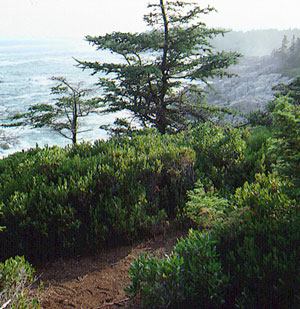Home → Bureaus & Programs → Maine Natural Areas Program → Communities, Plants, and Animals → Natural Community Fact Sheets → Rose Maritime Shrubland
Printer Friendly Fact Sheet - 1 MB pdf (Get a free copy of Adobe Acrobat Reader)
Rose Maritime Shrubland
Scientific Name: Rose - Bayberry Maritime Shrubland; State Rank: S4

- Community Description
- Soil and Site Characteristics
- Diagnostics
- Similar Types
- Conservation, Wildlife and Management Considerations
- Distribution
- Characteristic Plants
- Associated Rare Plants
- Associated Rare Animals
- Examples on Conservation Lands You Can Visit
Community Description: Medium height shrubs (1-2 m) usually cover 30-60% but may form dense thickets. Bayberry and roses are characteristic; raspberry and poison ivy are frequent associates. On some islands, shrublands are dominated by raspberry or bush-honeysuckle, with little or no bayberry or rose. Wild-raisin and winterberry may occur in more protected or moist pockets. Lowbush blueberry and northern dewberry are occasional as dwarf shrubs. Herbs grow in sometimes extensive patches among the shrubs and include salt tolerant shore species such as beach grass, beach-pea, sea-beach sandwort, seabeach angelica, and seaside goldenrod. Bryoids are absent, except for small amounts of lichens in some areas. Back to top.
Soil and Site Characteristics: These seaside bluffs and islands are exposed to onshore winds and salt spray; sometimes covering extensive areas on stabilized dunes or rocky islands. Exc